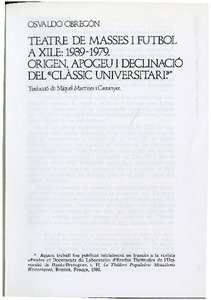Teatre de masses i futbol a Xile: 1939-1979

Visualitza/
Metadades
Mostra el registre d'unitat complet
Estudis escènics: quaderns de l'Institut del Teatre. 1984, Núm. 24
Tipus de documentArticle
Abstract
<p>The so-called “university classic” first appeared in Chile in 1939 as an introductory spectacle at a soccer match. As a show, it gradually developed into an authentic paratheatrical spectacle drawing audiences ranging in number, as the year would have it, from 50.000 to 80.000. Including the soccer match, which was the main reason for the Chilean “university classic”, the spectacle could last up to 5 hours. The event took place regularly twice a year and was carefully prepared by professionals of the theatrical world who were connected with Santiago's universities. It came to a sudden end when General Pinochet's military coup transformed the soccer stadium into a gigantic concentration camp. Drama critics rarely showed interest in the “university classic's” paratheatrical forms, which were commented on by sports columnists. The use of space and the central themes of the “classic” changed over the years, so that a frontal conception in which preference was given to the spectators in the Pacific tribunes, who were the most distinguished viewers in the stadium, was replaced by a conception closer to that of the circular theatre so that the action of he play could be observed comfortably from any seat. Another important formal characteristic was that of the “daytime classic” and the “night classic”: the latter included light effects which made it more spectacular than the former. From the ideological point of view the “classic” never cast doubt on the traditional values of Chilean society, rather it helped to exalt them while attempting to define “Chileanity”. Whenever occasional critical elements appeared the sports press advised a return to “common good sense”, in other words to eliminate negative material.</p>
Condicions d'accésAccés obert
ISSN2385-362X
,
0212-3819
Col·leccions
- 1984: Núm.: 24 [5]

